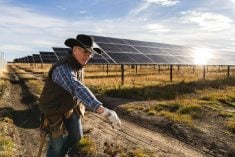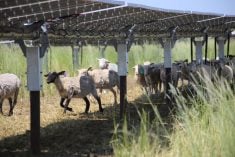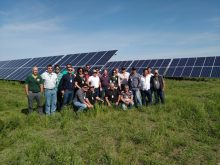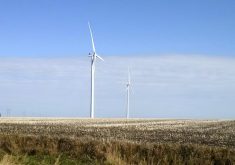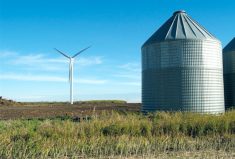Alberta may be oil and gas country, but right now, another natural resource is booming in the province — solar energy.
“Alberta is by far the fastest-growing solar market in Canada right now,” said Nicholas Gall, director of distributed energy resources for the Canadian Renewable Energy Association.
“Large corporate buyers — companies like Amazon, Budweiser, TransCanada — are seizing the unique opportunity offered by Alberta’s open electricity market to procure utility-scale wind and solar developments to offset their corporate electricity demands.
“Alberta’s really the only jurisdiction in Canada where this is possible, so demand that would have been spread out over other provinces is all accruing into Alberta.”
The province now has 12 solar facilities producing about 336 megawatts of power. There are another eight projects currently under construction that will collectively produce up to 537 megawatts of power.
“When we look at the total size of our grid at over 16,000 megawatts, that 537 megawatts is not that large, but from a newer technology standpoint, it is some fairly rapid adoption that we’re seeing in the province, similar to what we saw with wind about a decade ago,” said Mike Deising, director of communications and stakeholder relations for the Alberta Electric System Operator.
“It starts off a little bit slower, but then it accelerates.”
The Dawn of a New Energy Sector: Industrial-scale solar has been growing by leaps and bounds in Alberta in the last couple of years. So where does Alberta measure up in terms of capacity? Find out in the video below.
Read Also

The long march to autonomy
The big players in the machinery market keep adding pieces towards autonomous vehicles for farming, but how far away is a final product?
And that momentum is likely to continue. There are at least 87 more potential solar projects that have been proposed in the province, for a combined total of 8,000 megawatts.
Not all of those projects are a sure thing, though.
“It’s very important to note that, that does not mean they’re all moving forward. Those are projects that range from, ‘I think I may want to develop a solar facility,’ all the way to the ones where there’s actually construction happening,” said Deising.
“We don’t have the transmission infrastructure nor the need for an additional 8,000 megawatts of generation. Those are developers who are looking, they’re interested, they may have acquired land, and they’ve come to us and said, ‘We have an interest in developing a project.’”
Sound economics
And that interest is growing.
Aside from Alberta being one of the best solar resources in all of Canada, the province’s deregulated electricity market and zero-congestion transmission system are drawing investment in privately owned solar generators.
“There’s a massive amount of private unsubsidized investment taking place in Alberta today, where literally billions of dollars over the next couple of years are being invested in solar,” said David Vonesch, president of Skyfire Energy.
“They’re building these projects because the economics make sense. That’s a big statement. People are starting to see that there is a good opportunity here.”

That’s largely a result of incentive programs like the Renewable Energy Procurement program the NDP government implemented in 2016, he added.
“When it announced those programs, we saw lots of interest from international developers to start getting projects ready to build. That just spurred a ton of development work,” said Vonesch, adding the time to complete a large project means the industry is only now starting to see the impacts of those programs.
“When those wrapped up, it became really clear to those developers that there was an economic case with or without a government-run procurement process.”
Now as a result, every solar sector in Alberta is experiencing a “massive boom.”
“We’ve never seen this before, but every single sector right now is very active. There’s lots of interest, and it’s growing,” he said.
“It seems like all sectors are booming, everything from your residential new construction, municipalities, agriculture, commercial, small utility scale, big utility scale — there’s lots of opportunities in all markets right now.”
- Read more: Solar energy in Alberta facing a few storm clouds
- Read more: Boom delays pilot to convert abandoned well sites to solar
Solar opportunities for farmers
And it’s really the economics that are driving that increased demand. As solar technologies have improved, their price tag has dropped significantly.
“In terms of cost, solar is becoming the lowest-cost energy source on the market,” said Keith Hirsche, president of RenuWell Energy Solutions.
“When we look at any power generation project, we look at what the cost of building the project is, what the cost of operating the project on an annual basis is, and how much power is going to be generated every year over the lifetime of the project.
“If you look at the levelized cost of energy, the upfront costs on solar are higher, but your operating costs are so low that your levelized cost of energy over that whole project lifetime is approaching the cost of just buying the coal or the natural gas without building the plant.”
Solar technology is only continuing to improve, which will mean more energy generation on less land. Hirsche pointed to Brooks Solar, which is described by its owner (Vancouver-based Elemental Energy) as Western Canada’s “first utility-scale solar project” when it came online in 2017.
“For that first project in Brooks, they’re getting 15 megawatts out of that project now and it’s on 74 acres done with 200-and-some-watt modules,” said Hirsche.
“I suspect that in a few years, they’ll be in a position where they’ll take off the old modules and put on new modules and triple the capacity of the plant without any more land.”
Those economics allow developers to offer attractive lease rates to rural landowners, said Gall.
“It’s a very reliable source of revenue,” he said. “These sites are going to be producing power for decades. If I were a rural landowner, I would definitely be interested in the prospect of those steady lease payments potentially over decades.”
Other farmers are exploring solar to power their own operations, said Vonesch.
“Agriculture and solar have always been a really good fit. Most farmers are accustomed to making long-term investments, whether it be in equipment or land,” he said. “The longer-term economics of solar are certainly looked at more favourably than someone living in a house in the city where they’re not sure if they’re going to live there in five years.”
Rural communities also stand to benefit from the boom, added Vonesch. For example, Innisfail’s new 25-megawatt solar farm generates “a good chunk of money” for the town to invest back into its own infrastructure.
“Municipalities have started to see the oil and gas tax base start to diminish, and solar and wind projects are starting to fill that gap in a meaningful way,” he said.
“As more and more individuals and communities start to see more tax revenues, more jobs, and more lease payments, seeing those benefits really helps people accept solar a lot more.
“People buy into this transition to renewable energy when they can see those opportunities for themselves.”
Solar and irrigation
That’s what’s happening in Alberta’s irrigation districts, several of which either already have or are currently exploring solar projects on their land.
“It’s taking off in the irrigated area on different levels for sure,” said Richard Phillips, general manager of the Bow River Irrigation District.
“It’s not a new technology anymore that people don’t trust. It’s proven at this point, so people are getting into it.”
The Bow River Irrigation District currently has one commercial-scale solar project on a quarter section near Vauxhall.
“Our role is simply that of landlord,” said Phillips. “We’re not an investor in the project — we’ve simply leased land owned by the district to the solar company, on which it has built this solar farm. So we’re simply benefiting as a landlord collecting very attractive rent to benefit all of our irrigators.”
The 22-megawatt project was developed under the NDP government incentive program.
“There were a lot of solar companies tire kicking — basically just looking for anybody who might be willing to provide some land,” he said, adding that they entered into an agreement with a developer for two separate projects, one of which is still in the development stage.
“We’re developing a solar project that will be owned by us to power our pump stations,” said Phillips. “That’s a 400-kilowatt project, and that will be good for the district. That will meet its energy needs basically.”
Other irrigation districts are also exploring solar energy projects to power their infrastructure, he added. “I know at least one other district that’s looking at a very large commercial-scale solar project on its land as well.”
Phillips suspects that, that trend will continue not only among irrigation districts but also among irrigation farmers as the province’s $815-million investment in irrigation infrastructure starts to bear fruit.
“I know some farmers have put solar on their pivot corners to power their pump site. Talking with one of them, he’s been very impressed with the results he’s getting in terms of the power he’s producing off of panels in his pivot corners,” said Phillips.
“I expect we may see more of that in the future too. Certainly, there’s a great solar resource here. That’s why the big companies are chasing it, and we certainly can take advantage of it on a smaller scale too.”



